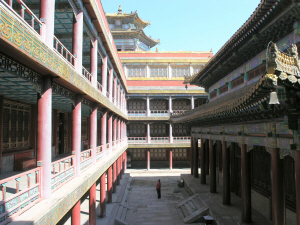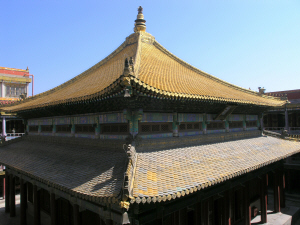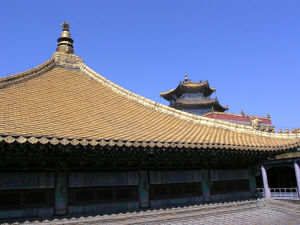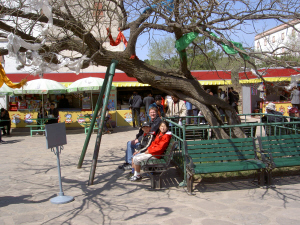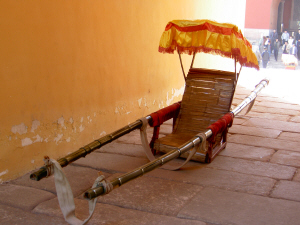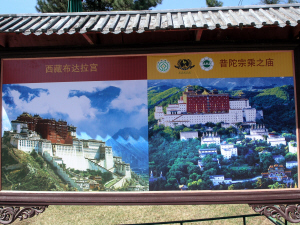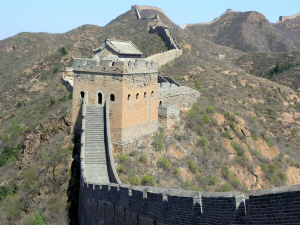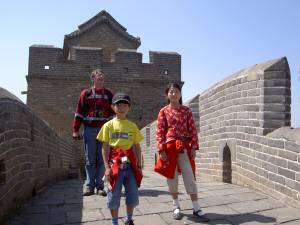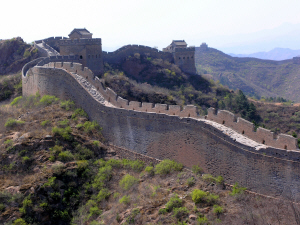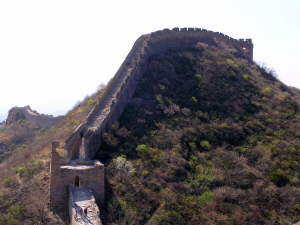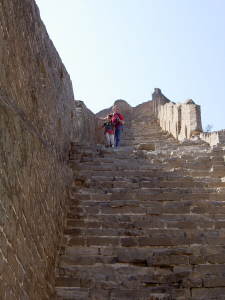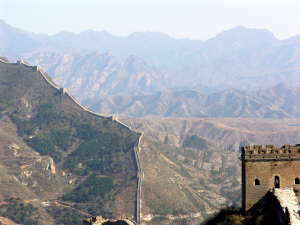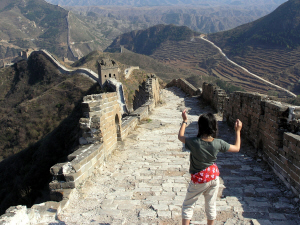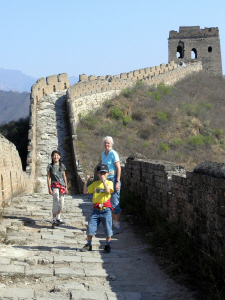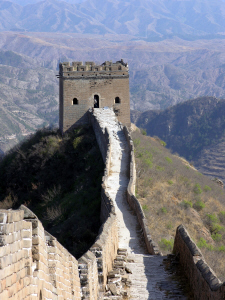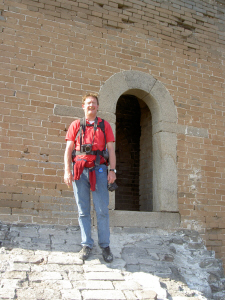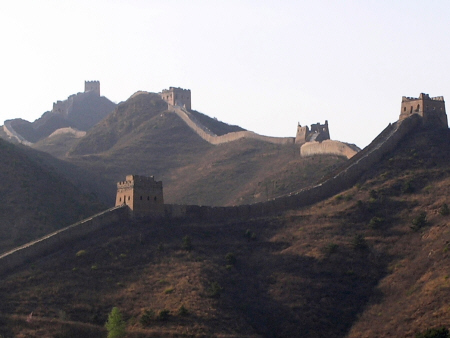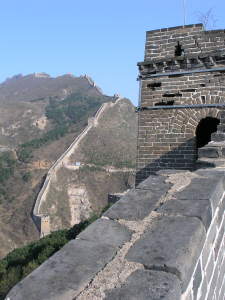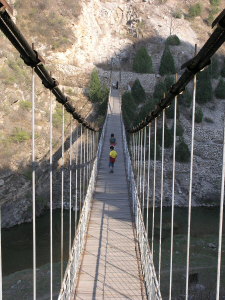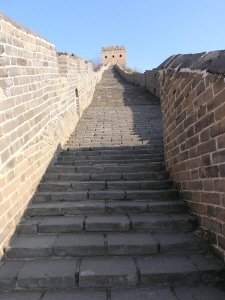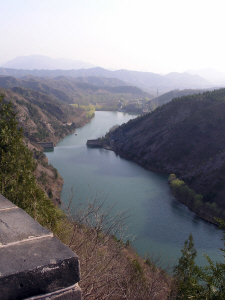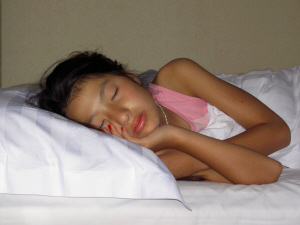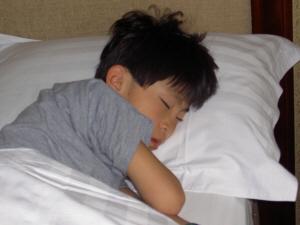|
Thursday April 16th, 2009 |
Chengde and the Great Wall,
Sunny – Max: 20; Min: 6; Avg: 13 |
We slept well and were up and ready for at 8am. The breakfast room was massive
and packed – the hotel was popular with Chinese tourist buses – there were ca.
10 parked outside and everybody eat at the same time. Luckily we arrived for
breakfast just as the groups were leaving. However we were stopped from eating
Chinese breakfast as we were to have a western breakfast – 2 fried eggs,
cucumber and tomato and 2 slices of untoasted sliced bread.
Besides luxurious quarters for the emperor and his court, palaces and
temples were built in Chengde both to house visiting dignitaries and to
impress them with the grandeur of the Chinese empire. The largest of these
buildings is the Putuozongcheng Temple, which is also called the Little Potala
Palace. The stone structure, built in 1771, was modelled on the Potala Palace in
Lhasa and has more than 60 halls and terraces. Even though it is not currently
used by monks, travellers who don't have the time or energy to take a trip to
Tibet, one can get the feeling of what the original palace looks like in Chengde - a massive maroon and white edifice with large square
windows.
It was an impressive palace, not least with the temple in the middle - built in
the inner courtyard. One of the guards approached us and asked whether we had
any coins from "our country". He was very happy that we had a few Danish coins
on us - Danish coins are always popular as they has holes in the middle. It was
good we were fairly early, as we came back down from the palace many large
groups were starting their trip up the stairs.
We met Ping outside, purchased some apples to take
with us, and made our way back towards Beijing. The initial goal wasn’t Beijing,
but the Great Wall at Jinshanling. In difference to Badaling and Mutianyu that
have been rebuilt to attract tourists, the walls at and between Jinshanling and
Simatai are largely original and falling apart. We planned to walk 10km from
Jinshanling to Simatai. We didn’t really know what to expect, but soon found out
that this was more than a walk along the wall – this was truly climbing the
wall. In some places the drops and climbs are 80 degrees without safe footing
underneath, and at times we were on all fours to stabilise ourselves.
However the views are truly unbelievable and even better in the near perfect
clear weather. You could follow the wall for kilometres – which didn’t make the
prospect of the walk any less daunting – it was clear to see how the wall went
up and down - first 100m almost directly upwards, 200m down and then 200m up
again.
We took the cable car up to the wall. Saturday’s long trek in PingAn and
yesterdays in Chengde were still sitting in our legs. At the top we were met by
the very aggressive vendors – a situation that was repeated all along the wall.
Steven made it very clear that were not interested in having them follow us
along the wall – a message that had to be repeated several times with different
vendors throughout the 10km trek - but at least it worked and we could walk in
peace.
There are next to no other tourists on this part of the wall. We met a
Norwegian/Austrian couple and one other person going in the same direction as
us, and two groups of 3 or 4 people going in the opposite direction. Apart from
them and the vendors we had the wall to ourselves.
The going was tough – Daji loved it and saw it as a great adventure, Yanmei was
a little more hesitant, but there was absolutely no problem for them to complete
the trip. At the end Lene concluded that it was good that we did this now, in a couple of
years we may no longer be up to it. It was true it was hard work. Steven was the
only casualty – again – a stone giving way under foot, so he fell sideways with
camera and video camera in hand. Luckily Steven only had a bruised hip and cut
up elbow, and the cameras survived.
Just before Simatai we had to cross the river across a suspension bridge – Daji and Yanmei ran across, Lene and Steven crossed more warily.
We left the wall at Simatai, but still had a fair walk to leave the entrance
area and find Ping and the car. We were tired and a happy and I suppose a bit
relieved to have completed the trip.
We drove to Beijing stopping to eat in one of Beijings many satellite towns -
Ping seemed to know the good places to eat.
According to Ping there are many people from Beijing that move to outskirts when
they get older – as these towns are often cheaper and less polluted.
We arrived back at the hotel at around 9pm – tired. Because of the problems we’d
experienced when we returned to the hotel on Saturday night and my complaint to the travel
agency who’d booked the hotel for us, the hotel had decided to upgrade us to the
executive floor. However the room and the beds were both smaller than a standard
room – the decor was slightly newer and the room had a computer. I suppose best
of all they offered Yanmei and Daji breakfast, which wasn’t included in our previous stays. (The funny thing
is, that during all the problems on the Saturday Steven had asked the duty
manager to give Yanmei and Daji breakfast on Sunday morning as compensation,
which he flatly refused. If he’d have said OK to that, Steven wouldn’t have
complained. Now that CWTS complained to the hotel, we were upgraded to the
executive floor and were given free breakfast for 3 days).
Despite the smaller beds, we slept almost immediately and well - we wondered how
stiff we were going to be the next morning.
NEXT
DAY (17th)
|

















